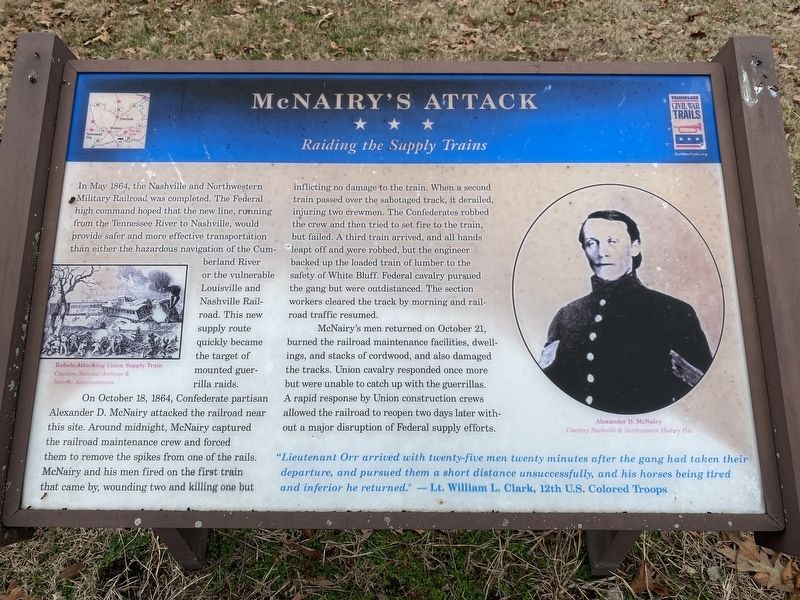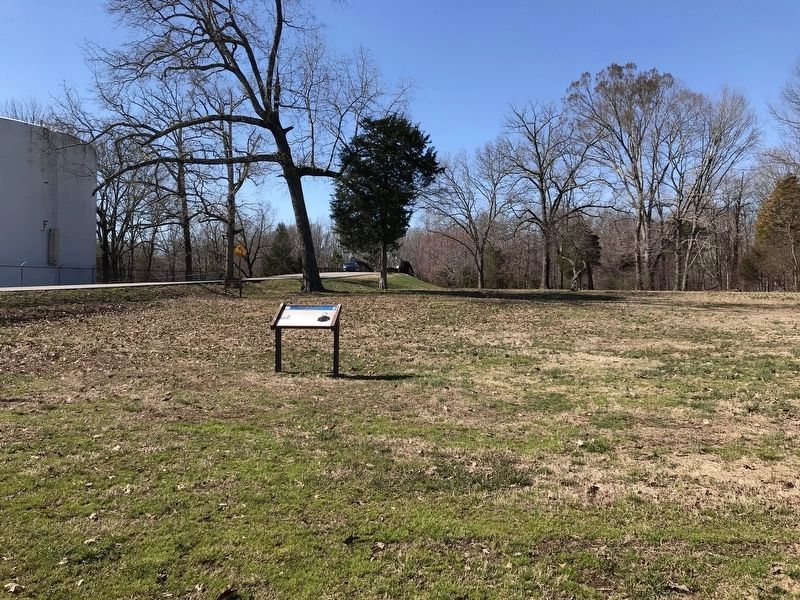White Bluff in Dickson County, Tennessee — The American South (East South Central)
McNairy’s Attack
Raiding the Supply Trains
In May 1864, the Nashville and Northwestern Military Railroad was completed. The Federal high command hoped that the new line, running from the Tennessee River to Nashville, would provide safer and more effective transportation than either the hazardous navigation of the Cumberland River or the vulnerable Louisville and Nashville Railroad. This new supply route quickly became the target of mounted guerrilla raids.
On October 18, 1864, Confederate partisan Alexander D. McNairy attacked the railroad near this site. Around midnight, McNairy captured the railroad maintenance crew and forced them to remove the spikes from one of the rails. McNairy and his men fired on the first train that came by, wounding two and killing one but inflicting no damage to the train. When a second train passed over the sabotaged track, it derailed, injuring two crewmen. The Confederates robbed the crew and then tried to set fire to the train, but failed. A third train arrived, and all hands leapt off and were robbed, but the engineer backed up the loaded train of lumber to the safety of White Bluff. Federal cavalry pursued the gang but were outdistanced. The section workers cleared the track by morning and railroad traffic resumed.
McNairy's men returned on October 21, burned the railroad maintenance facilities, dwellings, and stacks of cordwood, and also damaged the tracks. Union cavalry responded once more but were unable to catch up with the guerrillas. A rapid response by Union construction crews allowed the railroad to reopen two days later without a major disruption of Federal supply efforts.
"Lieutenant Orr arrived with twenty-five men twenty minutes after the gang had taken their departure, and pursued them a short distance unsuccessfully, and his horses being tired and inferior he returned."
—Lt. William L. Clark, 12th U.S. Colored Troops
(captions)
Rebels Attacking Union Supply Train Courtesy National Archives & Records Administration
Alexander D. McNairy Courtesy Nashville & Northwestern History File
Erected by Tennessee Civil War Trails.
Topics and series. This historical marker is listed in these topic lists: Railroads & Streetcars • War, US Civil. In addition, it is included in the Tennessee Civil War Trails series list. A significant historical date for this entry is October 18, 1864.
Location. 36° 4.64′ N, 87° 15.817′ W. Marker is in White Bluff, Tennessee, in Dickson County. Marker is at the intersection of Bakers Work road and Tennessee Route 47, on the right when traveling north on Bakers Work road. Located at the south entrance to Montgomery Bell State Park. Touch for map. Marker is in this post office area: White Bluff TN 37187, United States of America. Touch for directions.
Other nearby markers. At least 8 other markers are within 4 miles of this marker, measured as the crow flies. The Civilian Conservation Corps and Montgomery Bell State Park (approx. 0.8 miles away); The Old Log House (approx. 1.8 miles away); Cumberland Presbyterian Church Monument (approx. 1.9 miles away); The Civilian Conservation Corps (approx. 2 miles away); The CCC at Montgomery Bell (approx. 2 miles away); Birth of a Church (approx. 2.1 miles away); The Civil War in White Bluffs (approx. 3 miles away); "Lonesome" Cabin (approx. 3.6 miles away).
Credits. This page was last revised on March 9, 2020. It was originally submitted on December 26, 2019, by Darren Jefferson Clay of Duluth, Georgia. This page has been viewed 627 times since then and 54 times this year. Photos: 1. submitted on December 26, 2019, by Darren Jefferson Clay of Duluth, Georgia. 2. submitted on March 9, 2020, by Duane and Tracy Marsteller of Murfreesboro, Tennessee. • Bernard Fisher was the editor who published this page.

